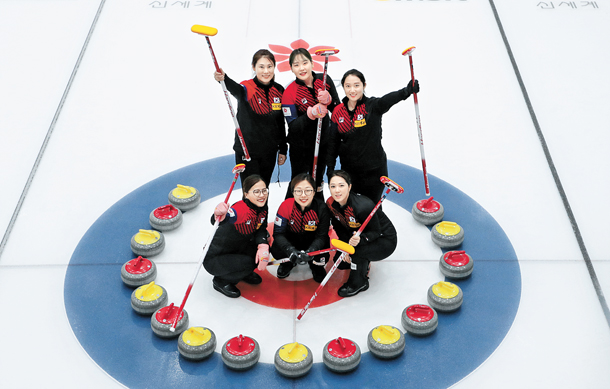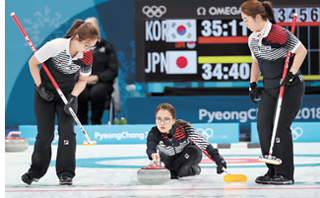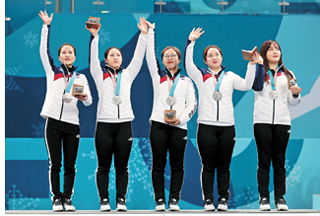Korean curling stars get used to the spotlight

Clockwise from top left: coach Kim Min-jung, alternate Kim Cho-hi, lead Kim Yeong-mi, third Kim Kyeong-ae, second Kim Seon-yeong and skip Kim Eun-jung pose at the Uiseong Curling Center in North Gyeongsang. [YONHAP]

Kim Eun-jung, center, slides the stone during Korea’s game against Japan at the 2018 PyeongChang Olympics at Gangneung Curling Centre in Gangwon on Feb. 23. [YONHAP]
Now that the dust has finally settled and the media frenzy has died down, the five members of Team Kim - skip Kim Eun-jung, lead Kim Yeong-mi, second Kim Seon-yeong, third Kim Kyung-ae and alternate Kim Cho-hi - and their coach Kim Min-jung have had time to adjust to their fame and consider what their success means for curling in Korea.
Team Kim made a name for themselves during the Olympics, as their Cinderella story captured the hearts of viewers around the world. Kim Eun-jung, in particular, quickly became a fan favorite, thanks to her stoic game-face and skill with the curling stone. Her fashionable glasses and emphatic yells of “Yeong-mi” - an attempt to encourage, or perhaps scare, her lead - proved to be perfect meme material, and the team quickly jumped to the top of social media trending list.
With a silver medal, Team Kim became the first Korean curling team to ever medal at the Olympics. But it wasn’t just the underdog story that attracted fans. The sportsmanship and team spirit the players displayed whenever they took to the curling sheet only boosted their popularity. With Russia noticeably absent due to a huge doping scandal, and a few instances of unsportsmanlike behavior on the ice rink, spectators were quickly drawn to Team Kim’s good-natured approach to the Games.
Yet throughout the Olympics, Team Kim had no idea they were getting so famous. When the team entered the athletes’ village, they gave up their phones, cutting themselves off from the outside world in order to focus on the tournament.
The Team Kim that visited the JoongAng Ilbo Building on May 8 was almost unrecognizable as the unflappable curling doyens that dominated at PyeongChang. Gone were the serious poker faces, the aversion to fame and, perhaps most noticeably, Kim Eun-jung’s glasses. Instead, Team Kim was relaxed, confident and not pulling any punches when it came to discussing the next steps forward for Korean curling.
Newfound fame

The Korean women’s curling team waves to fans during the awards ceremony at the Olympics. [YONHAP]
“It’s been three months but a lot of the people still recognize us and they tell us that they still cheer for us,” said Kim Min-jung, the coach, the only member of the team that was aware of the players’ fame during the Games.
“[During the Olympics], we didn’t know because we didn’t have our phones, but now that we know, we’re just thankful for all the attention we received from the fans,” said Kim Seon-yeong.
As the Olympics wrapped up and invitations for TV shows and product endorsements started flying in, Team Kim had to quickly come to terms with their popularity. It wasn’t until a month later, at the world championship in Canada on March 17, that the curlers realized that their fame transcended borders.
“We received a lot more recognition at the international event,” said Kim Min-jung. “Before, we weren’t the team that was favored [by fans or other teams].”
It wasn’t just the coach who felt the difference in reception from foreign fans. During Korea’s last match against the United States at the world championship, they received an enthusiastic welcome from the Canadian crowd.
“The foreign curling fans didn’t really know about us. But after the Olympics they congratulate us and ask for photos,” said Kim Yeong-mi. “We can definitely feel that they’re looking at us differently.”
“Every time we walk past the audience, they shout, ‘Great game at the Olympics!’,” said Kim Eun-jung. “They weren’t just Korean fans. We’ve advanced that far at international events before, but we’ve never received a lot of support. This time, there was definitely a different vibe in that fans cheered for us.”
Their newfound fame has impacted their lives at home as well.
“I’m thankful that a lot of people are recognizing me, but it was a little overwhelming at first because I have a quiet personality,” said Kim Yeong-mi. “So I don’t go out as much. I also started to get worried that there will be a big crowd of people when I go out to the city. Since I wasn’t used to getting that much attention, in the beginning I struggled not to panic.”
“I went to a restaurant once and the waiter told me that I look like Kim Seon-yeong from the curling team,” said Kim Seon-yeong from the curling team.
Surprisingly, the one member of the team that isn’t struggling with fans is the most famous, skip Kim Eun-jung.
“People don’t recognize me. If I don’t wear my glasses, people don’t realize who I am,” said Kim Eun-jung. “But I do hear a lot of people saying that I look like Kim Eun-jung.”
Crazy about curling
Four of the five members of Team Kim hail from Uiseong County in North Gyeongsang. It was there that curling was first introduced in Korea in the 1990s by Kim Min-jung’s father, Kim Kyung-doo.
In 2006, when most of Team Kim were either in middle school or high school, Kim Yeong-mi first suggested to Kim Eun-jung, now the group’s skip, that they start curling after school as a hobby. Later, Kim Kyung-ae, Kim Yeong-mi’s sister, joined the team after visiting the two at the curling center. Kim Seon-yeong was the last member of Team Kim from Uiseong to join, when Kim Kyung-ae wrote, “Anyone interested in curling?” on a board in her classroom.
Kim Cho-hi is the youngest member of the team, having joined in 2015 straight out of high school. She doesn’t come from North Gyeongsang like the rest of the team, and grew up in Uijeongbu, Gyeonggi. Like the rest of the team, Kim Cho-hi never really set out to be a professional curler - she took up the sport in middle school in order to get into a specific high school.
“There was this high school that I wanted to go to, but I needed good grades,” said Kim Cho-hi. “But my homeroom teacher at the time was a curling coach at the school, and I was told that I could attend the school if I played curling. That’s how I started.”
Kim Cho-hi was the skip for the Songhyun High School team. She earned the respect of the rest of Team Kim by defeating them at a national competition, and the team invited her to join them when she graduated.
The addition of Kim Cho-hi brought Team Kim to its present lineup, but the road to the Olympics wasn’t easy. Until the PyeongChang Olympics, curling was an afterthought in the Korean sporting world.
With little support from the Korean Sports Council or the Korean Sport & Olympic Committee, Team Kim was supported by Kim Kyung-doo and the Uiseong curling establishment.
Without financial support from the elder Kim, the team would never have been able to compete on an international level.
Kim Min-jung explained that her father was never dreaming of Olympic glory. His goal is to create an entirely new ecosystem for sports in Korea, by putting the focus on families and fun, not competition and victory.
The coach argues that this is reflected in why the team became so popular. The fact that they don’t look like they have spent their entire life concentrating on fitness makes them accessible to fans, she said.
“Look at them, they don’t even look athletic. There is not a single player on the team that was on a track and field team,” said Kim Min-jung. “This is the real story of Team Kim. It’s not a simple tale of a high school student asking her friend to start curling, its part of something much bigger.”
The future of the sport
Now that the profile of curling has grown in Korea, the team feels a lot more responsibility to perform better in the coming season to ensure the sport stays popular.
“If we can’t prove our skill in the next year or the year after, we’ll be forgotten [by the fans]. We’ll need to focus more and play better in international events,” said Kim Min-jung. “But at the same time, there needs to be more events within Korea to raise more awareness and increase the competitiveness of Korean teams.”
The players admitted that they feel some pressure on their shoulders, as they’re almost single-handedly responsible for raising curling’s profile in Korea. They have campaigned passionately to ensure that local and foreign media call them Team Kim, not the “Garlic Girls.”
“We want the [media] to call us Team Kim because it sounded like we were being used for political reasons,” said the coach. “The girls are young, so I wanted them to have a prettier nickname than garlic. And since the curling team’s name is decided by the surname of the skip, we thought Team Kim was more appropriate.”
The team is also worried that young Koreans won’t have the opportunity to become the next “Garlic Girls.” After the Olympics, a lot of children started looking up to the curling team, and the popularity of the sport is still growing. But it can be difficult for young curling enthusiasts to find somewhere to play.
“The curling center in North Gyeongsang was Korea’s first-ever curling center,” said Kim Min-jung. “There are now facilities in Taeneung, northern Seoul; Uijeongbu; Jincheon and Cheongju, North Chungcheong; Incheon and Daegu. We still don’t have enough, but there are facilities in every region.”
The team suggested that young people try signing up for curling camps, where they can train with professional athletes and learn the sport properly.
BY JIM BULLEY, KANG YOO-RIM [jim.bulley@joongang.co.kr]










with the Korea JoongAng Daily
To write comments, please log in to one of the accounts.
Standards Board Policy (0/250자)